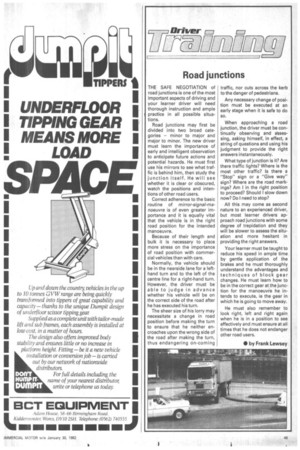Road junctions
Page 47

If you've noticed an error in this article please click here to report it so we can fix it.
THE SAFE NEGOTIATION of road junctions is one of the most important aspects of driving and your learner driver will need thorough instruction and ample practice in all possible situations.
Road junctions may first be divided into two broad categories — minor to major and major to minor. The new driver must learn the importance of early and intelligent observation to anticipate future actions and potential hazards. He must first use his mirrors to see what traffic is behind him, then study the junction itself. He will see whether it is clear or obscured, watch the positions and intentions of other road users.
Correct adherence to the basic routine of mirror-signal-manoeuvre is of even greater importance and it is equally vital that the vehicle is in the right road position for the intended manoeuvre.
Because of their length and bulk it is necessary to place more stress on the importance of road position with commercial vehicles than with cars.
Normally, the vehicle should be in the nearside lane for a lefthand turn and to the left of the centre line for a right-hand turn. However, the driver must be able to judge in advance whether his vehicle will be on the correct side of the road after he has executed his turn.
The sheer size of his lorry may necessitate a change in road position before making the turn to ensure that he neither encroaches upon the wrong side of the road after making the turn, thus endangering on-coming traffic, nor cuts across the kerb to the danger of pedestrians.
Any necessary change of position must be executed at an early stage when it is safe to do
SO.
When approaching a road junction, the driver must be continually observing and atsessing, asking himself, in effect, a string of questions and using his judgment to provide the right answers instantaneously.
What type of junction is it? Are there traffic lights? Where is the most other traffic? Is there a "Stop" sign or a "Give way" sign? Where are the road markings? Am I in the right position to proceed? Should I slow down now? Do I need to stop?
All this may come as second nature to an experienced driver, but most learner drivers approach road junctions with some degree of trepidation and they will be slower to assess the situation and more hesitant in providing the right answers.
Your learner must be taught to reduce his speed in ample time by gentle application of the brakes and he must thoroughly understand the advantages and techniques of block gear changes. He must learn how to be in the correct gear at the junction for the manoeuvre he intends to execute, ie the gear in which he is going to move away.
He must also remember to look right, left and right again when he is in a position to see effectively and must ensure at all times that he does not endanger other road users.
0 by Frank Lewsey
























































